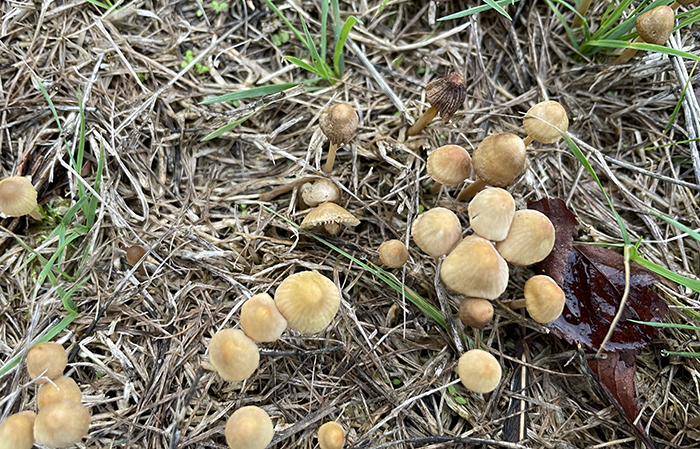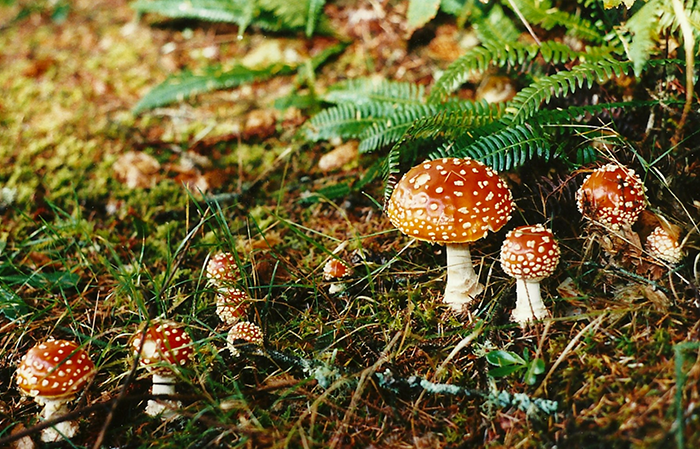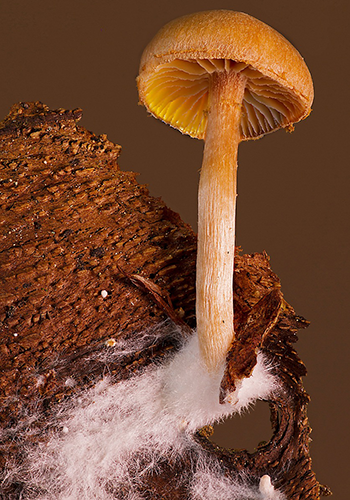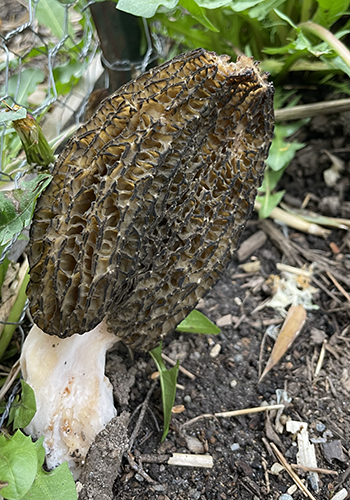Don’t Fear The Fungi
Here Come the Mushrooms
 With our long hot summers we almost forget what rain feels like! But now along with the fall rains, comes the mushrooms.
With our long hot summers we almost forget what rain feels like! But now along with the fall rains, comes the mushrooms.
Several days after the first soaking rain of the fall, I start to see mushrooms pushing their way through the grass and dried leaves in my garden. They can sometimes appear overnight and disappear within a few days, which I think adds to their mystique.
I’m always puzzled by the fear and anxiety that seems to pop up along with the fall mushrooms. Some people are afraid that these strange things that appeared overnight are damaging to gardens or lawns. Others worry that they may be poisonous to children or pets. Some even seem to believe that they’re dangerous just to have around.
Although there are certain types of mushrooms that ought to be treated with caution, these fears are generally unnecessary. Of course, it’s not a good idea to go around taste-testing mushrooms unless you seriously know what you’re doing, and it’s wise to keep an eye on young children to make sure they follow the same advice.
But the mushrooms in your garden aren’t hurting anything just by hanging around. In fact, they are a sign of a healthy ecosystem, and they are probably doing your garden a world of good!
So what’s up with all these mushrooms, anyway?
The Great Fungal Kingdom
 Did you know that fungi belong to their own kingdom? In terms of their phylogeny (evolutionary relationships), they are neither plants nor animals nor protists nor bacteria. Theirs is an ancient and independent lineage.
Did you know that fungi belong to their own kingdom? In terms of their phylogeny (evolutionary relationships), they are neither plants nor animals nor protists nor bacteria. Theirs is an ancient and independent lineage.
Many fungi may remind us of plants, but they’re actually more closely related to animals. And in some ways, they have more in common with us humans than plants do. For example, they can’t make their own food and instead need to eat.
There's so much to know about mushrooms. One of my favorite books to get started with is All That the Rain Promises and More by David Arora. If you want to learn how to identify and harvest mushrooms, make sure to get some great training from a trusted source first!
The great fungal kingdom includes the yeasts we use to make wine and bread, the tasty mold in our blue cheese, the not so tasty mold on those long-forgotten leftovers, and even the parasitic beasties that cause athlete’s foot. But for this article, we’ll focus on the soil-dwelling fungi that give rise to mushrooms.
Anatomy of a Fungus
 A mushroom is the fruiting body of an often vast underground network of mycelium. A mushroom is simply a reproductive organ, like the fruit on an apple tree. Its sole purpose is to pop up when conditions are right (for most garden fungi, that means damp!) and release its spores to create more fungi. That’s why you see mushrooms popping up quickly and disappearing just as suddenly – they’re just temporary structures made by much larger organisms that live in your soil year-round.
A mushroom is the fruiting body of an often vast underground network of mycelium. A mushroom is simply a reproductive organ, like the fruit on an apple tree. Its sole purpose is to pop up when conditions are right (for most garden fungi, that means damp!) and release its spores to create more fungi. That’s why you see mushrooms popping up quickly and disappearing just as suddenly – they’re just temporary structures made by much larger organisms that live in your soil year-round.
Mycelium, on the other hand, is the network of branching threads many of us have seen in rotting logs or in our blue cheese, and it makes up the vast majority of a fungus’s body. In fact, the largest living organism in the world is thought to be a fungus with mycelium spreading over 3.5 square miles underground. This gigantic fungus is thought to be at least 1,900 years old.
Have you thanked your mushrooms today?
 Although there are indeed a few kinds of fungi that make their living by parasitizing plants, most garden fungi are harmless, and many are extremely beneficial.
Although there are indeed a few kinds of fungi that make their living by parasitizing plants, most garden fungi are harmless, and many are extremely beneficial.
Remember how I said fungi, like animals, need to eat? Most of the ones that send up mushrooms each fall eat rotting stuff, and they are some of the most important decomposers in our gardens. These friendly fungi thrive in rich soil full of organic matter, where they join millions of microbes, worms, and other organisms to make up a healthy soil ecosystem.
Plants can’t do much with compost, manure, or organic fertilizers directly, yet these fungi foods provide essential nutrients that plants need. In essence, our plants need soil organisms such as fungi to pre-digest these foods for them. This is an absolutely essential service that we gardeners depend on, whether we know it or not.
Some fungi have even cozier relationships with our plants. These frisky fungi wind their mycelia right up around, or even inside, plant roots in order to more effectively exchange nutrients. The super-powered root/mycelium combinations that result are called mycorrhizae. Through these symbiotic relationships, plants share some of their sugars with their fungal friends, while the fungi improve the plants’ access to water and minerals.
Many scientists believe we're just beginning to understand our many reasons to thank the fungi. We've known that certain mushrooms have medicinal properties for a long time, with penicillin providing one famous example. Now, new research suggests that particular fungi found in native trees and logs might be able to help our ailing honeybees ward off disease.
Fungi aren’t just a sign of a thriving garden ecosystem, they are essential to the well being of our plants and friendly insects. Besides, the mushrooms they produce are fun and beautiful to look at! I like to think of them as bonus perennials.
So when you see those mushrooms poking up their heads, don’t forget to thank them – they’re the only part you can see of a vast underground network working to keep your garden thriving.
How many mushrooms can you find in your garden this fall?

